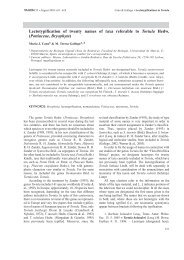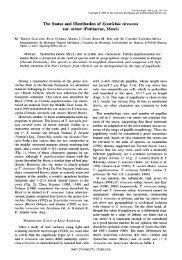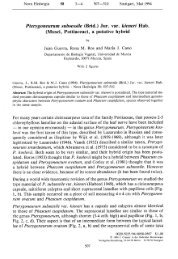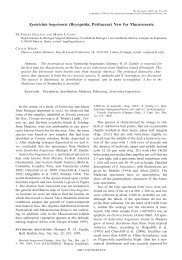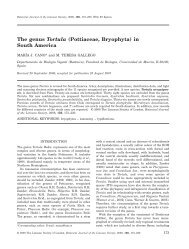Bryological Monograph An annotated checklist of the mosses of ...
Bryological Monograph An annotated checklist of the mosses of ...
Bryological Monograph An annotated checklist of the mosses of ...
Create successful ePaper yourself
Turn your PDF publications into a flip-book with our unique Google optimized e-Paper software.
MOSSES OF EUROPE AND MACARONESIA 231differences and recognize several species. NorthAmerican authors stress <strong>the</strong> presence <strong>of</strong> intergradingforms and recognize only one species, F. bryoidesHedw. On both continents many specimens are easilyidentified as F. bryoides sensu stricto (with numerousaxillary an<strong>the</strong>ridial buds), F. viridulus (most an<strong>the</strong>ridiaterminal on dwarf male or longer plants) or F. incurvus(incurved capsules). Also on both continents sexualcharacters are more or less correlated to o<strong>the</strong>rcharacters (extension <strong>of</strong> <strong>the</strong> limbidium, shape <strong>of</strong> <strong>the</strong>leaf apex, sporophyte, etc.). Intergrading specimensare also known from both continents and are probablymost common in sou<strong>the</strong>rn and nor<strong>the</strong>rn regions.Whe<strong>the</strong>r <strong>the</strong>y are more common in North Americais unknown. In <strong>the</strong> Ne<strong>the</strong>rlands most specimens canbe easily identified. Variation in sexuality in Europeanmaterial <strong>of</strong> this complex has led to <strong>the</strong> description <strong>of</strong>many varieties and species. In this <strong>checklist</strong>, we adopta conservative (from a European point <strong>of</strong> view)perspective, but omit F. exiguus Sull. and F. kosaniniiLatzel, and reduce F. curnovii and F. incurvus tovarietal rank.95. Cortini Pedrotti (2001) and Smith (2004) treatFissidens bryoides var. caespitans at species level. It ishere included as variety because, though extremeforms are clearly distinct from F. bryoides var.bryoides by red rhizoids, a thicker limbidium, inclinedcapsules and a cushion-like growth form, manycollections cannot be identified with certainty.96. In a recent provisional publication Pursell (2005)recognizes Fissidens minutulus as a distinct species,closely related to, yet distinct from, F. crispus(including F. limbatus). We are not convinced that<strong>the</strong> two taxa are distinct in Europe and <strong>the</strong>y aretreated as synonyms here.97. Fissidens gymnandrus is treated by North Americanauthors and Ignatov & Afonina (1992) as a synonym<strong>of</strong> F. bryoides. However it differs from F. bryoidessensu stricto in being polyoicous, having oblong leaveswith a wide apex, and by its preference for woodysubstrates in regularly flooded localities.98. Fissidens jansenii was described by Sérgio & Pursell(2001). The resemblance <strong>of</strong> this species to Fissidensrufulus was overlooked by its authors. Both specieshave small cells and limbidia that reach <strong>the</strong> insertion<strong>of</strong> <strong>the</strong> dorsal laminae. F. jansenii has bistratose leaves;<strong>the</strong> leaves <strong>of</strong> F. rufulus are irregularly bistratose orunistratose.99. Fissidens microstictus is a relatively unknown speciescharacterized by stems with numerous wide, ellipticalto ovate leaves, broad, acute leaf tips and dorsallaminae that are narrowed below and typically reach<strong>the</strong> insertion. All leaves <strong>of</strong> a stem can be elimbate orlimbate, or limbate and elimbate leaves may occur on<strong>the</strong> same stem, limbidia are found on <strong>the</strong> vaginantlaminae and sometimes also in <strong>the</strong> middle <strong>of</strong> <strong>the</strong>dorsal laminae. It is closely related to F. arnoldii fromwhich it differs in <strong>the</strong> broadly acute not acuminate leaftips.100. Fissidens nobreganus resembles F. sublineaefoliuswhich also has linear leaves and smooth cells. Itdiffers from this species in having bud-shaped axillaryperigonia and perigonia terminal on short axillarybranches, by smaller, almost isodiametric laminal cellsand limbidia that are restricted to <strong>the</strong> upper leaves <strong>of</strong>perichaetial plants. Fissidens sublineaefolius has terminalperigonia, larger, hexagonal laminal cells andwell-developed limbidia on all laminae <strong>of</strong> all leaves.101. Fissidens perssonii was synonymized with F. ovatifoliusby Dirkse, Bouman & Losada-Lima (1993).102. Fissidens pusillus is treated by North Americanauthors as an expression <strong>of</strong> F. bryoides.103. European specimens identified as Fissidens exiguus arepoorly limbate forms <strong>of</strong> ei<strong>the</strong>r F. viridulus or <strong>of</strong> F.pusillus. Fissidens exiguus is treated by NorthAmerican authors as a poorly limbate expression <strong>of</strong>F. bryoides.104. Fissidens sublimbatus was reported from <strong>the</strong> CanaryIslands by Ros et al. (2001).105. Fissidens viridulus is treated by North Americanauthors as an expression <strong>of</strong> F. bryoides.106. Bryum pallens, Dicranum polysetum, D. viridulum(Fissidens), Hypnum revolvens (Scorpidium) andOrthotrichum pumilum are Swartz names from beforeSpecies Muscorum that were validated in a bookreview (<strong>An</strong>on., 1801); thus ‘ex anon.’.107. Fissidens viridulus var. incurvus is linked to var.viridulus by transitional forms. North Americanauthors treat both taxa as expressions <strong>of</strong> F. bryoides.108. Re-examination <strong>of</strong> <strong>the</strong> isotype <strong>of</strong> Fissidens bambergeriin U showed that it is a poorly limbate form <strong>of</strong>F. viridulus. It differs from F. crispus (F. limbatus)with which it has been confused by larger, hardlybulging, less than twice as deep as wide, laminalcells.109. Fissidens marginatulus is not accepted by Ignatov &Ignatova (2003) and seems hardly distinct from F.viridulus.110. Fissidens serratus was reported as F. papillosus, newfor <strong>the</strong> Canary Islands, by Dirkse, Bruggeman-Nannenga & Bouman (1991). Bruggeman-Nannenga& Pursell (1995) treated F. papillosus as a synonym <strong>of</strong>F. serratus.111. Ceratodon antarcticus Cardot and C. heterophyllusKindb. have been reported from arctic and alpineparts <strong>of</strong> Europe. According to Ochyra (1998), C.antarcticus is merely a developmental phase <strong>of</strong> C.purpureus with very large mid-leaf cells and plane leafmargins. European records <strong>of</strong> C. heterophyllus arebased on plants that lack capsules and <strong>the</strong>reforeaccording to <strong>the</strong> account <strong>of</strong> Burley & Pritchard (1990)are not reliable. Never<strong>the</strong>less, <strong>the</strong> occurrence in coldparts <strong>of</strong> Europe <strong>of</strong> Ceratodon plants with rounded,entire leaf apices is remarkable. Cultivation experi-




